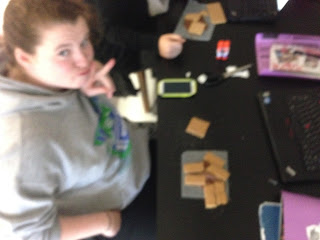http://www.windows2universe.org/teacher_resources/teach_snacktectonics.html
DIRECTIONS:
1.Make the model
a.Give each student about a square foot of wax paper and a large dollop of frosting. Instruct students to spread frosting into a layer about half a cm thick.
b.Tell students that the frosting in this model represents the asthenosphere, the viscous layer on which Earth's plates ride. The plates in this model are represented by fruit roll up (oceanic crust which is thin and dense) and graham crackers (continental crust which is thick but less dense).
2.Divergent plate boundary
a.Instruct students to place the two squares of fruit roll up (oceanic plates) onto the frosting right next to each other.
b.Press down slowly on the fruit roll ups (because they are dense and will sink a bit into the asthenosphere) as you slowly push them apart about half a cm.
c.Notice how the frosting is exposed and pushed up where the plates are separated? This is analogous to how magma comes to the surface where real plates are moving apart at divergent plate boundaries. Most divergent plates boundaries are located within oceanic crust. When plates begin to pull apart at continents, rift valleys are made, like the great rift valley in Africa, which can become the bottom of the sea floor if the plates continue to pull apart.
3.Transform plate boundaries
a.Pick the two crackers up off the frosting and turn them around so that two dry edges are next to each other.
b.Push one cracker past the other to simulate a transform plate boundary like the San Andreas fault!

















No comments:
Post a Comment